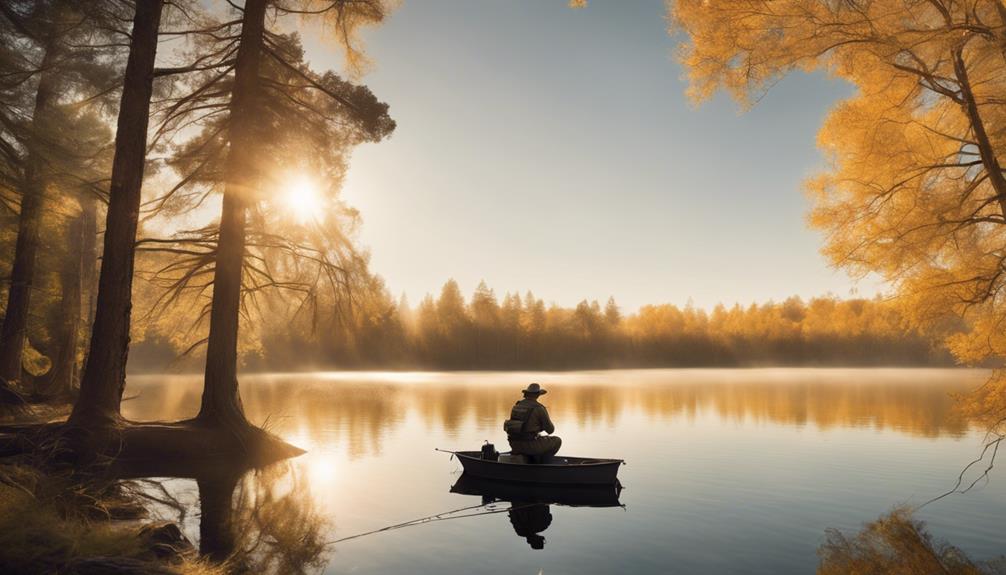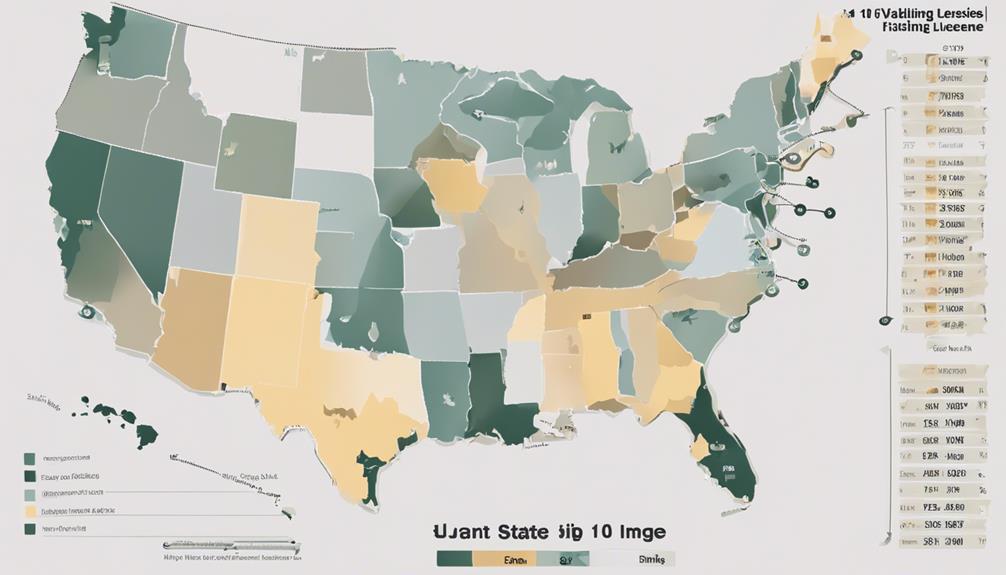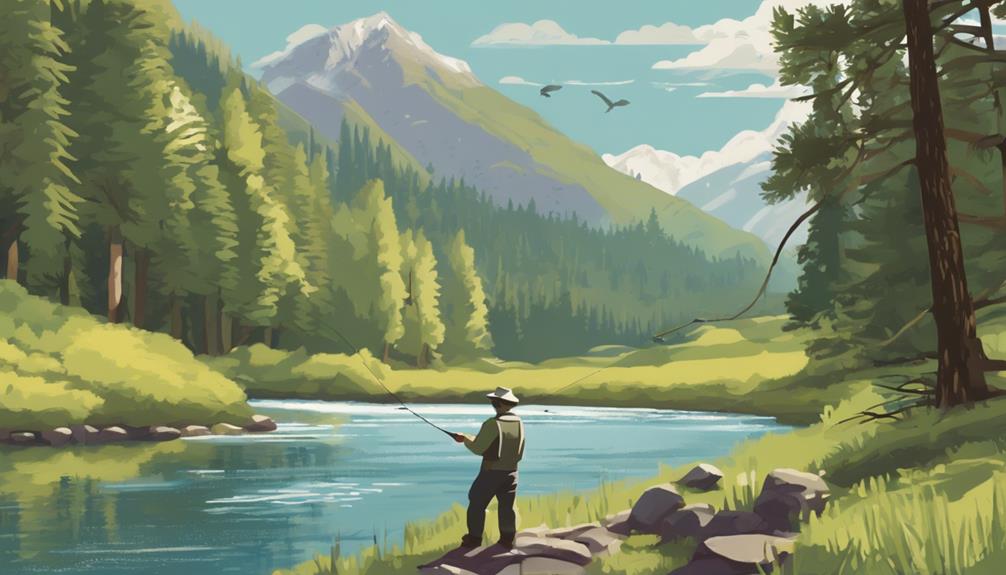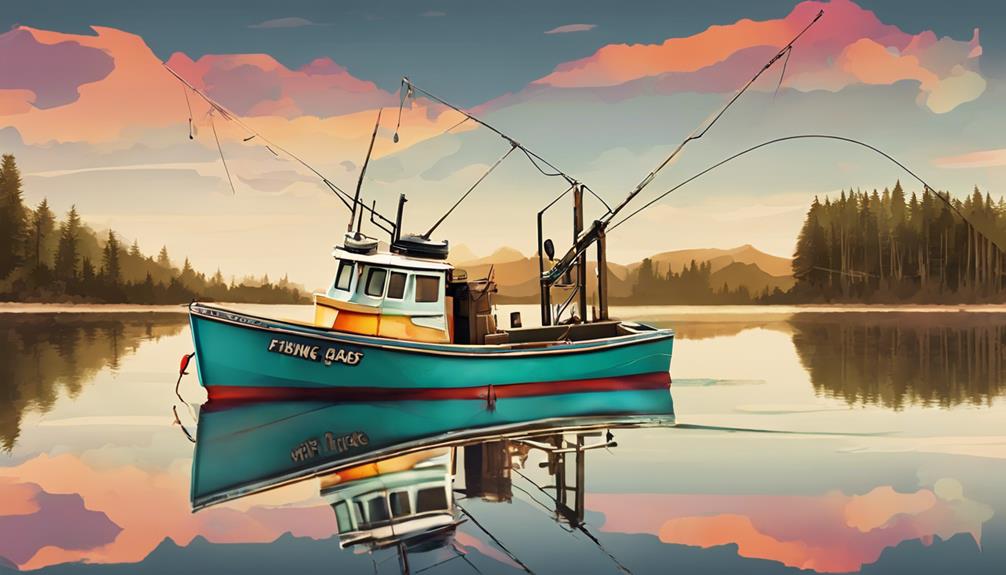Imagine you're hiking along the serene streams of Yellowstone National Park, and you notice a group of anglers casting their lines into the crystal-clear waters. Have you ever wondered why national parks implement strict fishing regulations?
These rules go beyond just managing recreational activities; they play a crucial role in safeguarding the delicate balance of ecosystems and ensuring the long-term health of fish populations.
But why exactly do national parks have fishing regulations in place? Let's explore the underlying reasons together.
Importance of Fishing Regulations
Understanding why fishing regulations are crucial can significantly enhance your fishing experience and contribute to the preservation of our national parks. When you follow these regulations, you play a vital role in maintaining the balance of fish populations within the natural ecosystems of these parks.
Fish populations are essential components of the natural ecosystems found in national parks. By adhering to fishing regulations, you help ensure that these populations remain stable and healthy. Overfishing can disrupt the delicate balance of species within an ecosystem, leading to detrimental effects on not only the fish themselves but also other wildlife that depend on them for food.
Moreover, fishing regulations are designed to protect the overall health of natural ecosystems. By preventing overfishing and implementing guidelines on catch limits and sizes, these regulations help preserve the biodiversity and sustainability of aquatic environments. This, in turn, contributes to the overall health and resilience of the national park as a whole.
Conservation of Fish Populations
To ensure the conservation of fish populations in national parks, strict adherence to fishing regulations is paramount. Population management strategies are put in place to maintain the delicate ecological balance within these habitats. Here are three key reasons why these regulations are crucial:
- Preservation of Biodiversity: By controlling fishing activities, national parks can prevent overfishing of certain species. This helps maintain a diverse range of fish populations, which is essential for the overall health of the ecosystem. When specific fish species are overexploited, it can disrupt the food chain and lead to imbalances in the environment.
- Sustainable Fisheries: Fishing regulations aim to promote sustainable fishing practices that allow fish populations to replenish naturally. By setting limits on the number and size of fish that can be caught, parks can ensure that fishing activities don't deplete fish stocks to unsustainable levels. This approach supports the long-term viability of fisheries within the park.
- Protection of Habitat: Healthy fish populations are indicators of a well-functioning ecosystem. By conserving fish populations, national parks indirectly protect the habitats that these fish rely on. This protection extends to other species that are interconnected with fish in the food web, contributing to the overall ecological balance of the park.
Protection of Natural Habitats
In safeguarding the natural habitats within national parks, strict conservation measures are essential to uphold the integrity of these ecosystems. Habitat preservation is crucial to maintain the delicate balance of flora and fauna that make up these unique environments. National parks serve as crucial refuges for a wide variety of species, providing them with a protected space free from the disturbances of human activities. By regulating fishing activities, park authorities can ensure that these habitats remain undisturbed and that the ecosystems within them can thrive.
Ecosystem balance is a delicate state that can be easily disrupted by human interference. Fishing regulations help control the impact of human activities on these habitats, preventing overfishing that could destabilize the natural food chain and lead to detrimental effects on the entire ecosystem. By limiting fishing in specific areas or imposing catch limits, authorities can better manage the delicate balance within these habitats.
Preserving natural habitats within national parks isn't just about protecting individual species; it's about safeguarding the intricate web of life that exists within these areas. Every plant, animal, and organism plays a crucial role in maintaining the health of the ecosystem. By enforcing fishing regulations and promoting habitat preservation, national parks can continue to serve as havens for biodiversity and ensure the long-term sustainability of these precious natural environments.
Preservation of Biodiversity
Preserve biodiversity by implementing strict conservation measures to protect the variety of life within national parks. Biodiversity conservation is crucial for maintaining ecosystem balance, ensuring that all species within the park have the necessary resources to thrive.
Here are three key ways in which national parks preserve biodiversity:
- Habitat Protection: National parks establish protected areas where wildlife can live without disturbances from human activities. By safeguarding these habitats, parks provide safe spaces for diverse plant and animal species to flourish.
- Invasive Species Control: Invasive species can disrupt the delicate balance of ecosystems by outcompeting native species for resources. National parks implement measures to control and eradicate invasive species, preventing them from causing harm to the park's biodiversity.
- Endangered Species Conservation: National parks often serve as important habitats for threatened and endangered species. Park authorities work to protect these vulnerable populations through conservation programs aimed at increasing their numbers and ensuring their survival for future generations.
Sustainable Fishing Practices
Implement sustainable fishing practices to ensure the long-term health and abundance of fish populations within national parks. Sustainable management of fishing activities is crucial to maintain the delicate balance of aquatic ecosystems. By practicing ethical harvesting techniques, you can help preserve fish populations for future generations to enjoy.
When engaging in fishing activities within national parks, it's essential to follow sustainable practices. This includes respecting catch limits, using appropriate gear to minimize harm to non-target species, and releasing undersized or protected fish unharmed. By adhering to these guidelines, you contribute to the overall health of fish populations and their habitats.
Ethical harvesting involves treating fish with respect and care. This means avoiding wasteful practices such as overfishing or taking more fish than needed. By only harvesting what you intend to consume and properly handling and storing your catch, you can ensure that fish populations remain stable and healthy.
Participating in sustainable fishing practices not only benefits the environment but also enhances the fishing experience for everyone. By being mindful of your impact on fish populations and their habitats, you can help preserve these resources for current and future generations to enjoy. Remember, responsible fishing today ensures abundant fish populations for tomorrow.
Prevention of Overfishing
Promote responsible fishing practices to combat the threat of overfishing in national parks. Overfishing can disrupt the delicate ecosystem balance within these protected areas, leading to long-lasting negative effects on the environment. By implementing regulations that focus on resource management, national parks can ensure the sustainability of their aquatic populations for future generations.
Here are three key strategies to prevent overfishing and maintain ecosystem balance in national parks:
- Catch and Release Policies: Encourage visitors to practice catch and release fishing, especially for species that are at risk of being overfished. This approach helps preserve the population size of vulnerable species and supports overall ecosystem health.
- Education and Outreach Programs: Raise awareness among park visitors about the importance of sustainable fishing practices. Providing information on local fishing regulations, endangered species, and the impact of overfishing can help individuals make informed decisions while enjoying recreational fishing activities.
- Monitoring and Research Initiatives: Implement monitoring programs to track fish populations and study the effects of fishing activities on the ecosystem. By collecting data and conducting research, park authorities can make well-informed decisions to protect aquatic resources and maintain a healthy balance within the park's waters.
Enforcement of Catch Limits
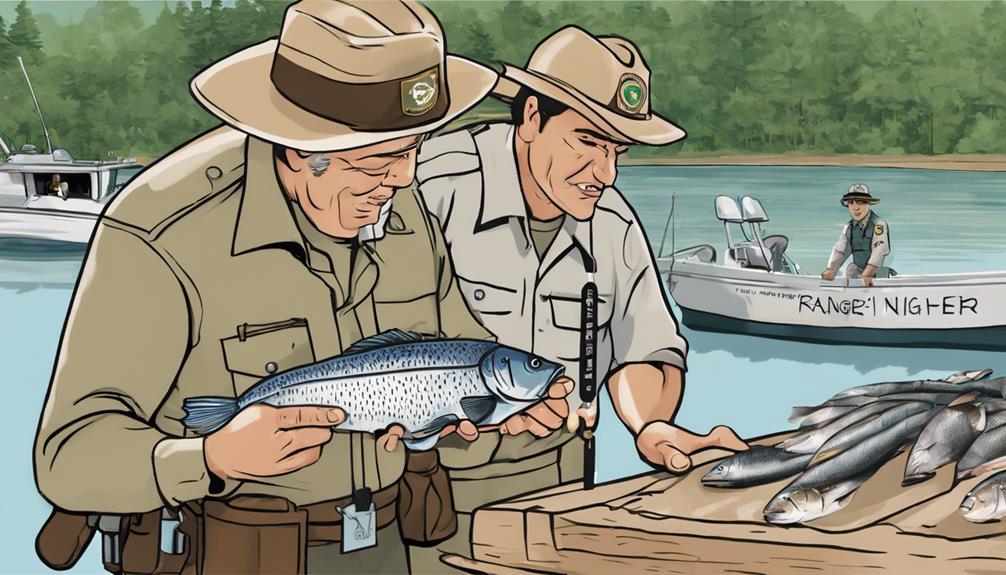
To ensure the sustainability of aquatic populations in national parks, adherence to catch limits is crucial in regulating fishing activities. Catch limits are set to prevent overfishing and ensure that fish populations can replenish themselves. However, enforcing these catch limits poses several challenges for national park authorities.
One of the main enforcement challenges is the vast area that needs to be monitored. National parks can span hundreds of square miles, making it difficult for park rangers to keep a close eye on all fishing activities. Additionally, some anglers may try to evade catch limits by fishing in remote or less monitored areas of the park.
To tackle these enforcement challenges, national park authorities employ various monitoring techniques. One common method is regular patrols by park rangers who check fishing licenses and inspect catches to ensure they're within the set limits. Technology is also being increasingly used, such as the installation of cameras in popular fishing spots or the use of drones to survey larger areas efficiently.
Despite these efforts, enforcing catch limits remains a continuous challenge. It requires a combination of manpower, technology, and community involvement to ensure that anglers comply with regulations and contribute to the conservation of aquatic ecosystems in national parks.
Promoting Responsible Angling
Encouraging anglers to respect catch limits and handle fish with care fosters a culture of responsible fishing in national parks. By promoting ethical fishing practices, national parks aim to maintain a sustainable environment for both fish populations and other wildlife. Here are three ways national parks promote responsible angling:
- Catch and Release Programs: Many national parks advocate for catch and release practices to help conserve fish populations. By releasing fish back into the water unharmed, anglers contribute to the preservation of the aquatic ecosystem.
- Education and Outreach: National parks often provide educational materials and conduct outreach programs to inform anglers about the importance of ethical fishing practices. Understanding the impact of irresponsible angling can help individuals make more informed decisions while fishing.
- Partnerships with Conservation Organizations: Collaborating with conservation organizations allows national parks to implement effective wildlife management strategies. These partnerships help in monitoring fish populations, enforcing regulations, and promoting sustainable fishing practices within park boundaries.
Frequently Asked Questions
Can I Fish in National Parks Without a Fishing License?
You can't fish in national parks without a fishing license. Fishing restrictions are in place to protect the environment and wildlife. License requirements ensure that anglers follow rules and regulations to maintain the balance of the ecosystem.
Always check with the specific national park you plan to visit for their fishing guidelines and regulations. Remember, respecting these rules helps preserve the natural beauty of these protected areas for future generations to enjoy.
Are There Restrictions on the Types of Fishing Equipment Allowed in National Parks?
Yes, there are restrictions on the types of fishing equipment allowed in national parks. When it comes to fishing techniques in these areas, conservation efforts are critical. Make sure to check the specific rules for each park as they may differ, but commonly prohibited equipment includes dynamite, chemicals, or other harmful methods.
Using sustainable and traditional fishing gear helps protect the delicate ecosystems within the parks.
How Are Invasive Species Managed in National Park Waters to Protect Native Fish Populations?
To protect native fish populations in national park waters, invasive species management is crucial. Conservation efforts aim to control and eradicate invasive species that threaten the ecosystem.
Are There Designated Fishing Seasons in National Parks?
In national parks, designated fishing seasons are established to protect fish populations during sensitive times of the year. It's essential to follow these guidelines to uphold fishing ethics and support conservation efforts.
By respecting these seasonal restrictions, you contribute to the preservation of native species and their habitats, ensuring that future generations can also enjoy the beauty of park waters.
Make sure to check the specific rules for each park you visit to fish responsibly.
What Measures Are in Place to Ensure the Safety of Fish Populations During Fishing Tournaments or Competitions in National Parks?
When fishing tournaments happen in national parks, catch limits are strictly enforced to protect fish populations. This ensures conservation and sustainability of the environment.
Measures like size restrictions help reduce the environmental impact of these competitions.
Conclusion
So next time you're out fishing in a national park, remember that these regulations are in place for a reason. By following the rules and practicing responsible angling, you're helping to conserve fish populations, protect natural habitats, and preserve biodiversity for future generations to enjoy.
So grab your gear, follow the rules, and enjoy the beauty of nature while respecting the importance of fishing regulations in national parks.
